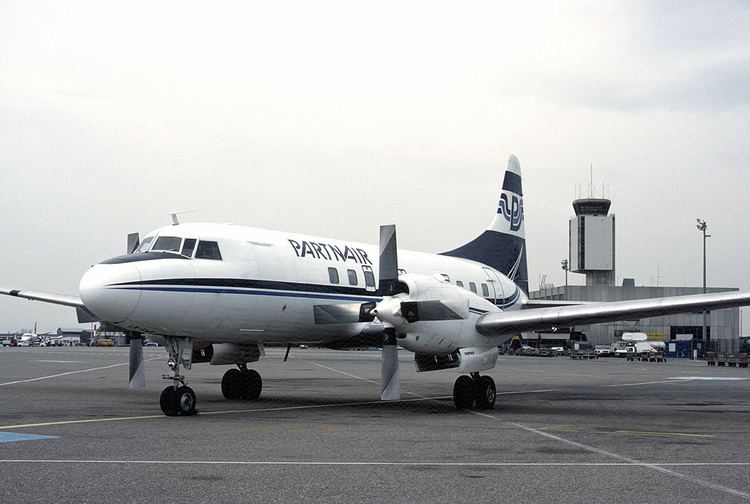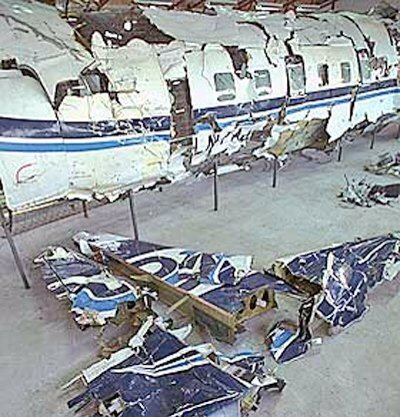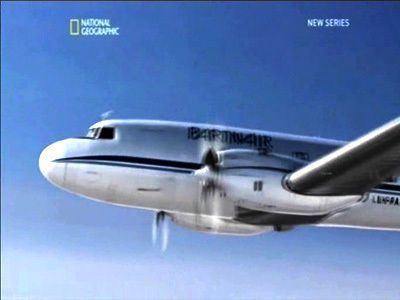Passengers 50 Survivors 0 Date 8 September 1989 Fatalities 55 (all) Passenger count 50 | Crew 5 Survivor 0 Location Denmark | |
 | ||
Summary Improper maintenance, rudder malfunction due to substandard parts Similar Air Ontario Flight 1363, Air France Flight 296, Atlantic Southeast Airlines Fl, Air France Flight 358, Ethiopian Airlines Flight 409 | ||
Mayday air crash investigation s07 e03 blown apart partnair flight 394
Partnair Flight 394 was a chartered flight which crashed on 8 September 1989 off the coast of Denmark 18 km north of Hirtshals. All 50 passengers and 5 crew members on board the aircraft perished, making it the deadliest civilian aviation accident involving an all-Norwegian airline company. It was also the highest death toll of any aviation accident involving a Convair 580, and the biggest aeroplane accident in Denmark. It was caused by use of unapproved aircraft parts in repairs and maintenance.
Contents
- Mayday air crash investigation s07 e03 blown apart partnair flight 394
- Aircraft
- Background
- Flight
- Investigation
- Aftermath
- Dramatization
- References

Aircraft
The aircraft, registered LN-PAA, was a 36-year-old Convair CV-580 operated by the charter airline Partnair. The plane had switched owners several times and had various modifications. The aircraft had multiple previous registrations, N73128, EC-FDP, PK-GDS, HR-SAX, JA101C, N770PR and C-GKFT and had been rebuilt after a landing accident in 1978. The most significant modification was a change from piston engines to turboprop engines in 1960; this added more horsepower to the aircraft. A Canadian company that specialized in servicing Convairs was the owner of the aircraft before Partnair acquired it. LN-PAA was one of the most recently acquired aircraft in the Partnair fleet. At the time of the crash, there were 2 other Convair 580 in the Partnair fleet.
Background
At the time of the accident Partnair was in financial difficulty. The airline's debts were such that, on the day of the accident flight, Norwegian aviation authorities had notified Norwegian airports to not allow Partnair aircraft to depart since Partnair had not paid several charges and fees.
Flight
The Convair 580 aircraft was en route from Oslo Airport, Fornebu, Norway to Hamburg Airport, West Germany. The passengers were employees of the shipping company Wilhelmsen Lines who were flying to Hamburg for the launching ceremony of a new ship. Half of the employees of the company's head office were on board. Leif Terje Løddesøl, an executive of Wilhelmsen, said that the atmosphere in the company was "very very good" prior to the accident flight. He said that some of the employees "maybe" had been to prior naming ceremonies, which he described as "quite exciting." A regular employee on the flight, one of the top-performing employees in the company, had been asked to give the speech during the launching ceremony. Løddesøl said that it was not often that a "normal person" in the company was chosen to read the speech at the naming ceremony.

The flight crew consisted of Captain Knut Tveiten and First Officer Finn Petter Berg, both 59. Tveiten and Berg were close friends who had flown together for years. Both pilots were very experienced, with close to 17,000 flight hours each. Berg was also the company's Flight Operations Manager.

Before the flight, the crew found that one of the two main power generators had not worked since 6 September, and the mechanic who inspected the aircraft was unable to fix it. In the Norwegian jurisdiction an aircraft is only allowed to take off if it has two operable sources of power. Also the aircraft's Minimum Equipment List required two operating generators. The first officer decided that he would run the auxiliary power unit (APU) throughout the flight so that the flight would have two sources of power and therefore be allowed to leave.

The airport refused to let the flight go until the catering bill was paid. Before the aircraft took off, the first officer left the cockpit to pay the catering company. As a result of this, the plane was delayed almost an hour, finally departing at 3:59 p.m.

As the Partnair aircraft passed over the water at planned cruising attitude - 22,000 feet, a Norwegian General Dynamics F-16 Fighting Falcon fighter jet passed by it. The fighter pilot was startled by the sudden appearance of the aircraft and contacted Oslo air traffic control. He believed that the radar data were false and that the aircraft was closer to his jet than his on-board computer had indicated.
As the aircraft neared the Danish coastline, 22,000 feet (6,706 m) over the North Sea, Copenhagen Air Traffic Control sees that the flight is off course and falling quickly, appearing to crash into the sea, roughly 20 km north of the Danish coast.
Investigation
Accident Investigation Board Norway (AIBN) investigated the disaster. Fifty of the 55 bodies were recovered. The recovered bodies were given autopsies in Denmark. Investigators used side-scan sonar to plot positions of wreckage. The pieces had settled over an area 2 kilometres (1.2 mi) wide. This told the investigators that the aircraft disintegrated in the air. The investigators re-constructed 90% of the aircraft.
The cockpit voice recorder (CVR) usually records the final minutes of an accident flight. In the Partnair crash it had recorded the start of the flight and stopped shortly before the aircraft took off. From the maintenance records investigators found that, 10 years prior to the accident flight, the cockpit voice recorder had been modified so that the CVR would use the aircraft's generator instead of the aircraft's battery if full power was applied for takeoff. As the generator was inoperative on this flight, this meant that power to the CVR cut out as the aircraft took off.
Some initial speculation in Norwegian press stated that a bomb brought down Partnair. In December 1988, a bomb had brought down Pan Am Flight 103. In addition, Norwegian Prime Minister Gro Harlem Brundtland had used that particular Partnair aircraft on her campaign trips. The Norwegian press believed that the crash was a failed assassination attempt. Witnesses of the crash said that they heard a loud noise as they saw the aircraft fall. The fact that the aircraft had disintegrated in the air gave credibility to the bomb theory. The speculation in the press later included a scenario where the plane had been shot down by the NATO war exercise "Operation Sharp Spear," which took place on the day of the accident flight near the flight path, as investigators had found small traces of high-powered military explosives on parts recovered from the sea bed. Investigators found that the residue was not from a bomb, nor was it from a warhead, as there was not enough of it present. Finn Heimdal, an AIBN investigator, said in an interview that the residue appeared to be more like a contamination than any other possibility. The sea had old munitions as many battles had been fought off the coast of Denmark. Investigators concluded that the aircraft pieces acquired residue from the bottom of the sea or that the traces of RDX military explosives were explained by contamination before the accident or due to storage.
Metallurgist Terry Heaslip of the Canadian company Accident Investigation and Research Inc. examined the aircraft skin from the tail and found signs of overheating, specifically that the skin had been flexed, through a phenomenon known as flutter. This caused investigators to further scrutinize the tail of the aircraft. Furthermore, the investigation team found that the Auxiliary Power Unit (APU), which was in the tail, had melted plastic parts from the cabin present inside the turbine. This indicated that the APU was operating during the flight; normally the APU would not be operating when the aircraft was in flight. The mechanic who had inspected the aircraft on the day of the accident flight told the investigators that one of the aircraft's two main generators had failed and that he was not able to repair the faulty generator. The investigators discovered that the pilots had noted in the flight log that they operated the APU during the flight, since two power sources are required for redundancy. They also discovered that one of the three mounts holding the APU was broken.
The two shroud doors on the aircraft tail were not present in the recovered tail. The doors, constructed with an aluminium honeycomb liner, had reflective properties also found in aluminium foil, which made the doors appear on radar when floating free. This led the AIBN to conclude that the unidentified objects tracked at a high altitude by Swedish radar for 38 minutes were likely the shroud doors, which had separated from the aircraft tail. From this, the AIBN found that the tail failed at 22,000 feet. If the rudder moved in a violent manner, the weights behind the doors would also move violently and hit the shroud doors. Therefore, the rudder had made a violent movement as the accident unfolded.
Partnair suggested said that the F-16 fighter jet had been flying at a faster velocity and closer to the Convair than reported in the media. Therefore, the jet, which would have broken the supersonic barrier at that point, would have created a supersonic pressure wave that would have caused the Convair to disintegrate in mid-air. The National Aeronautical Research Institute, a Swedish aviation technology research facility, said that there was a 60% chance of this being the cause. The Norwegian F-16 pilot testified that his aircraft was more than 1,000 ft (300 m) above the Convair. The investigators concluded that the F-16 would have had to have been within a few metres of the Convair to have affected the passenger aircraft; the investigators had no evidence that the two aircraft were that close together, and the AIBN investigation found no connection to the accident. After the final report was issued, there was speculation that the AIBN had doubted the radar information that it received, leading the Thoresen brothers to file a lawsuit, but a ruling in the Norwegian lagmannsrett (intermediate court) dismissed this in 2004.
The flight data recorder (FDR), an antiquated analog model, used a rotating metal foil strip and marking pins which scratched the strip. The FDR did not record all of the parameters that it was supposed to record, mainly vertical acceleration readings were missing and heading indications were abnormal. The needle recorded some lines twice, initially confusing the investigators. The team sent the FDR to the American company which manufactured it. The manufacturer asked an ex-employee, the highest expert regarding the company's flight data recorders, to leave retirement to examine the FDR. The expert concluded that the needle supposed to have been recording the altitude had been shaking so much that it left another mark on the foil. The particular FDR was able to record for hundreds of hours; the expert unspooled the foil and found that the needle had been shaking for months. This told investigators that another component, not just the APU with the recently broken mount, had been vibrating. The investigators charted the vibrations and found that two months before the crash, the vibrations stopped for two weeks. Afterward, the vibrations increased up to the accident flight. Investigators found that during the two-week period in July 1989 the aircraft received a major overhaul in Canada by the airline's previous owner. When the Canadian company made test flights and during the aircraft's first several passenger flights for Partnair, the FDR recorded almost no abnormal vibrations. When the investigators reviewed the maintenance records, they found that, during the overhaul, mechanics discovered wear on one of the four bolts/pins that connected the vertical fin to the fuselage. During the overhaul, the mechanic replaced one of the bolts/pins. The vibrations stopped after the bolt/pin was replaced. Investigators found all four bolts/pins that held the tail on to the fuselage.
Heaslip found that the three bolts/pins that were not replaced were not authentic parts and were incorrectly heat-treated during manufacture. Therefore, these three bolts each had 60% of their intended strength, making them too weak for regular usage on the aircraft. After the period without vibration, the tail vibrated for 16 completed flights and the accident flight.
The investigators concluded that the APU and tail vibrations reached the same frequency and went into synchronization, a phenomenon known as resonance, causing a coupled harmonics force (similar to the one that caused the Tacoma Narrows Bridge collapse in 1940); the force of each vibration wave would add to that of another vibration, increasing in amplitude until the structure failed and the tail broke off.
Aftermath
As a result of the accident, safeguarding against counterfeit aircraft parts increased. Peter Friedman, an expert on counterfeit parts, stated in an episode of the television programme Mayday (Air Crash Investigation, Air Emergency) that the Partnair accident was the "seminal event" that caused people around the world to recognize the proliferation of counterfeit aircraft parts in parts inventories. The spare aircraft parts industry had little regulation in many places in the world at the time of the Partnair accident. The United States Department of Transportation (USDOT), which oversees the Federal Aviation Administration (FAA), examined the scope of the spare parts in the United States. The USDOT audited the FAA's inventory and found that 39% of the parts in the bins were counterfeit. The fraudulent parts came from a parts broker that was prominent in the parts broker industry; 95% of the parts in that broker's inventory were counterfeit. Mary Schiavo, the former inspector general of the USDOT, said that American parts brokers had "no regulation whatsoever." Schiavo said that an individual with a telephone and a fax machine could become a parts broker and could get his or her parts from a variety of sources, including junkyards, scrap facilities, older aircraft, aircraft involved in accidents and incidents, and illegal parts manufacturers. Counterfeit parts were often less expensive than authentic parts. Friedman said that "bottom line-driven" airlines, including those on the verge of bankruptcy, wanted to cut costs, driving them to acquire false parts.
The FAA investigated false parts and captured illegal parts dealers in sting operations. The FAA found that there was an industry for making thousands of worn and inferior parts to look like newly manufactured parts. At the time of the Partnair accident, aircraft parts were required to have documentation with signatures indicating that the parts were authentic. The FAA found that illegal business counterfeit FAA tags to make the parts appear authentic. Schiavo said that many of the operators signed the tags with counterfeit signatures of real inspectors. Friedman said that the tags had more monetary value than the actual illegal parts. The Americans initially believed that the proliferation of false parts mainly affected only smaller airlines; Schiavo said that smaller airlines and repair stations were usually the businesses that were the most likely to accept false parts. The FAA later found counterfeit parts in larger operations; in particular Air Force One, the aircraft used by the President of the United States, had fraudulent parts. As a result, illegal parts dealers faced arrests and convictions. Schiavo said that the most important action taken by the United States government regarding the proliferation of counterfeit parts was to cause the convictions of the parts dealers. The FAA created a more rigorous documenting system to prevent the proliferation of fake aircraft parts. Airlines would receive criminal charges if they knowingly accept defective aircraft parts. In the 2000s, Schiavo said that counterfeit parts are not proliferated as often because there is more regulation in that time period than in the 1980s and the 1990s.
Dramatization
The crash was featured in Season 7 of the Canadian made, internationally distributed documentary series Mayday, on the episode "Blown Apart".
